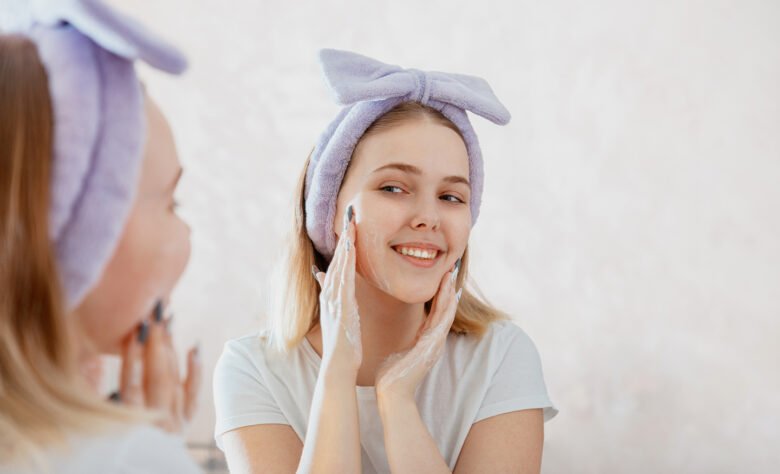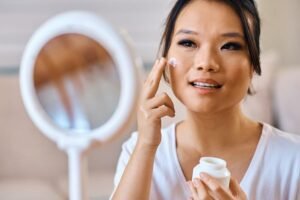Navigating the world of skincare can often feel overwhelming. With countless products lining the shelves and endless advice circulating online, it’s easy to get lost in the noise. You might wonder if that trendy serum is right for you, or why a moisturizer that works wonders for your friend leaves your skin feeling greasy. The secret to unlocking a radiant complexion isn’t about finding a single magic product; it’s about understanding your unique skin.
Think of your skin as a unique blueprint. What works for one person might not work for another, and the key is to identify its specific needs. This guide will help you do just that. We’ll walk you through identifying your skin type, from oily to sensitive and everything in between. You’ll learn how to build a personalized skincare routine with the right ingredients and discover practical tips for maintaining healthy skin year-round. By the end of this post, you’ll be equipped with the knowledge to make informed decisions, debunk common myths, and finally create a skincare regimen that makes you feel confident and beautiful.
Understanding the Different Skin Types
The first and most crucial step in any skincare journey is identifying your skin type. Your skin type is determined by genetics, but it can also be influenced by factors like climate, hormones, and lifestyle. Knowing where you fit in helps you select products that will work with your skin, not against it. There are five primary skin types.
Normal Skin
If you have normal skin, consider yourself lucky! This skin type is well-balanced, meaning it’s neither too oily nor too dry.
- Characteristics: Normal skin typically has fine pores, a smooth texture, and a clear, even complexion. It rarely experiences breakouts, flakiness, or feelings of tightness. The oil (sebum) production is balanced, keeping the skin naturally moisturized without feeling greasy.
- Common Issues: People with normal skin have few concerns. Occasional pimples might pop up due to hormonal changes or stress, but widespread issues are uncommon. The main goal for this skin type is maintenance and protection.
Oily Skin
Oily skin is characterized by an overproduction of sebum, which can give the skin a persistent shine.
- Characteristics: If you have oily skin, you’ll likely notice enlarged pores, especially around the nose, chin, and forehead (the T-zone). Your face may feel greasy throughout the day, and makeup might seem to slide off.
- Common Issues: The excess oil can clog pores, leading to frequent blackheads, pimples, and cystic acne. While the extra oil can help keep wrinkles at bay for longer, managing shine and preventing breakouts is the primary challenge.
Dry Skin
Dry skin produces less sebum than normal skin, leaving it feeling tight and sometimes flaky.
- Characteristics: This skin type often has nearly invisible pores and may feel rough to the touch. It can look dull due to a lack of natural oils. After cleansing, dry skin often feels tight and uncomfortable.
- Common Issues: Dry skin is prone to fine lines, redness, and irritation. It can be easily affected by environmental factors like cold weather and low humidity, which can exacerbate flakiness and cracking. Without proper moisture, the skin’s protective barrier can become compromised.
Combination Skin
As the name suggests, combination skin features a mix of two or more different skin types on the face.
- Characteristics: The most common form of combination skin is an oily T-zone (forehead, nose, and chin) with normal or dry cheeks. You might have enlarged pores and blackheads in the oily areas, while your cheeks feel tight or look flaky.
- Common Issues: The biggest challenge is finding a balance. Products designed for oily skin might be too harsh for the dry areas, while rich creams can cause breakouts in the T-zone. It requires a strategic approach, sometimes using different products on different parts of your face.
Sensitive Skin
Sensitive skin is not so much a skin type as it is a condition that can accompany any of the above types. However, it’s often discussed as a primary category due to its specific needs.
- Characteristics: Sensitive skin is easily irritated and reactive. It may be prone to redness, itching, burning, and stinging sensations.
- Common Issues: This skin type reacts negatively to certain ingredients, fragrances, and even environmental triggers. Conditions like rosacea, eczema, and contact dermatitis are common. The key is to use gentle, soothing products and avoid known irritants.
Building Your Ideal Skincare Routine
Once you know your skin type, you can start building a routine that caters to its needs. A basic routine consists of cleansing, moisturizing, and sun protection, but you can add targeted treatments to address specific concerns.
Choosing the Right Cleanser
The foundation of any good routine is a cleanser that effectively removes dirt, oil, and makeup without stripping the skin’s natural moisture barrier.
- Normal Skin: A gentle gel or foam cleanser works well.
- Oily Skin: Look for a foaming or gel cleanser with ingredients like salicylic acid or benzoyl peroxide to help control oil and prevent breakouts.
- Dry Skin: A creamy, hydrating, or oil-based cleanser is best to cleanse without drying out the skin. Ingredients like glycerin and hyaluronic acid are excellent.
- Combination Skin: A gentle, balancing foaming cleanser is a good starting point. You might find it beneficial to use a slightly stronger cleanser on your T-zone.
- Sensitive Skin: Opt for a fragrance-free, hypoallergenic cream cleanser with soothing ingredients like chamomile or aloe vera.
Serums and Treatments
Serums are concentrated formulas designed to address specific concerns like aging, dullness, or acne.
- For Anti-Aging: Retinoids (like retinol) and peptides are powerful ingredients for boosting collagen and reducing fine lines.
- For Brightening: Vitamin C is a potent antioxidant that helps fade dark spots and even out skin tone. Niacinamide also helps with redness and pigmentation.
- For Hydration: Hyaluronic acid is a humectant that draws moisture into the skin, making it look plump and hydrated.
- For Acne: Salicylic acid (a BHA) exfoliates inside the pores to clear out clogs, while benzoyl peroxide kills acne-causing bacteria.
Selecting a Moisturizer
Every skin type needs a moisturizer to hydrate the skin and lock in moisture. The texture and ingredients will vary based on your needs.
- Normal Skin: A lightweight lotion provides sufficient hydration.
- Oily Skin: A light, oil-free, non-comedogenic gel or lotion is ideal. It will hydrate without clogging pores.
- Dry Skin: A rich, thick cream containing ceramides, shea butter, or nourishing oils will help repair the skin barrier and prevent moisture loss.
- Combination Skin: You might need two different moisturizers—a lightweight one for your T-zone and a richer one for your cheeks—or a balanced gel-cream formula.
- Sensitive Skin: A simple, fragrance-free moisturizer with minimal ingredients is best. Look for products designed to calm and repair the skin barrier.
Sunscreen: The Non-Negotiable Step
Sunscreen is the most important step in any skincare routine, regardless of your skin type. Daily use prevents sun damage, premature aging, and skin cancer.
- Oily/Acne-Prone Skin: Choose a lightweight, oil-free, non-comedogenic formula. Mineral sunscreens with zinc oxide can also have a mattifying effect.
- Dry Skin: Look for a moisturizing sunscreen with hydrating ingredients like hyaluronic acid.
- Sensitive Skin: Mineral-based sunscreens (containing zinc oxide and titanium dioxide) are generally less irritating than chemical sunscreens.
Essential Skincare Tips and Practices
Beyond products, certain habits can make a huge difference in your skin’s health.
- Be Gentle: Avoid harsh scrubbing or using water that is too hot, as this can strip the skin’s protective barrier.
- Patch Test New Products: Before applying a new product to your entire face, test it on a small, discreet area (like behind your ear) for a few days to check for any adverse reactions.
- Stay Consistent: Results don’t happen overnight. Stick with your routine for at least 4-6 weeks to see if it’s making a difference.
- Adjust for Seasons: Your skin’s needs can change with the weather. You may need a richer moisturizer in the winter and a lighter one in the summer.
- Don’t Forget Your Lifestyle: A balanced diet, adequate hydration, regular exercise, and sufficient sleep all contribute to healthy, glowing skin.
Common Skincare Myths Debunked
With so much information available, it’s easy to fall for myths. Let’s clear up a few.
- Myth: Oily skin doesn’t need a moisturizer.
Fact: Oily skin absolutely needs hydration. When you strip the skin of its natural oils (often with harsh cleansers), it can overcompensate by producing even more oil. An oil-free, lightweight moisturizer will keep your skin balanced. - Myth: The higher the SPF, the longer you can stay in the sun.
Fact: A higher SPF offers more protection, but the difference is marginal after SPF 30. SPF 30 blocks about 97% of UVB rays, while SPF 50 blocks about 98%. No sunscreen offers 100% protection, and all sunscreens need to be reapplied every two hours. - Myth: You only need sunscreen on sunny days.
Fact: Harmful UV rays can penetrate clouds and windows. You should wear sunscreen every single day, regardless of the weather or whether you’re staying indoors. - Myth: Natural ingredients are always better.
Fact: “Natural” doesn’t automatically mean safe or effective. Some natural ingredients, like certain essential oils or lemon juice, can be highly irritating to the skin. Conversely, many lab-created ingredients are incredibly beneficial and well-researched for safety.
Achieve Your Best Skin Ever
Understanding your skin is the foundation of an effective skincare routine. By identifying your skin type and its unique needs, you can move past the confusion and build a regimen that truly works for you. Remember to choose products with the right ingredients, apply them consistently, and listen to what your skin is telling you. A personalized approach, combined with healthy lifestyle habits, is your ultimate path to achieving a radiant, healthy complexion that you can feel proud of.
Frequently Asked Questions (FAQ)
1. How can I determine my skin type at home?
A simple way is the “wash and wait” method. Wash your face with a gentle cleanser, pat it dry, and wait for 30 minutes. If your skin feels tight and flaky, it’s likely dry. If it looks shiny all over, it’s oily. If your T-zone is shiny but your cheeks are not, you have combination skin. If it feels comfortable and balanced, you have normal skin.
2. How often should I exfoliate?
It depends on your skin type and the type of exfoliant. Over-exfoliating can damage your skin barrier. Generally, 1-2 times a week is sufficient for most people. Oily skin might tolerate up to 3 times a week, while dry and sensitive skin should stick to once a week with a gentle exfoliant.
3. In what order should I apply my skincare products?
The general rule is to apply products from thinnest to thickest consistency. A typical order would be: Cleanser -> Toner (optional) -> Serum -> Eye Cream -> Moisturizer -> Sunscreen (in the morning).
4. Do I really need a separate eye cream?
While not strictly necessary for everyone, eye creams are formulated specifically for the delicate skin around the eyes. This area is thinner and more prone to fine lines and dryness. If you have specific concerns like dark circles or puffiness, a targeted eye cream can be very beneficial.
5. Can my skin type change over time?
Yes, your skin type can change due to hormonal shifts (like pregnancy or menopause), aging, climate changes, and even certain medications. It’s a good idea to reassess your skin’s needs periodically and adjust your routine accordingly.




